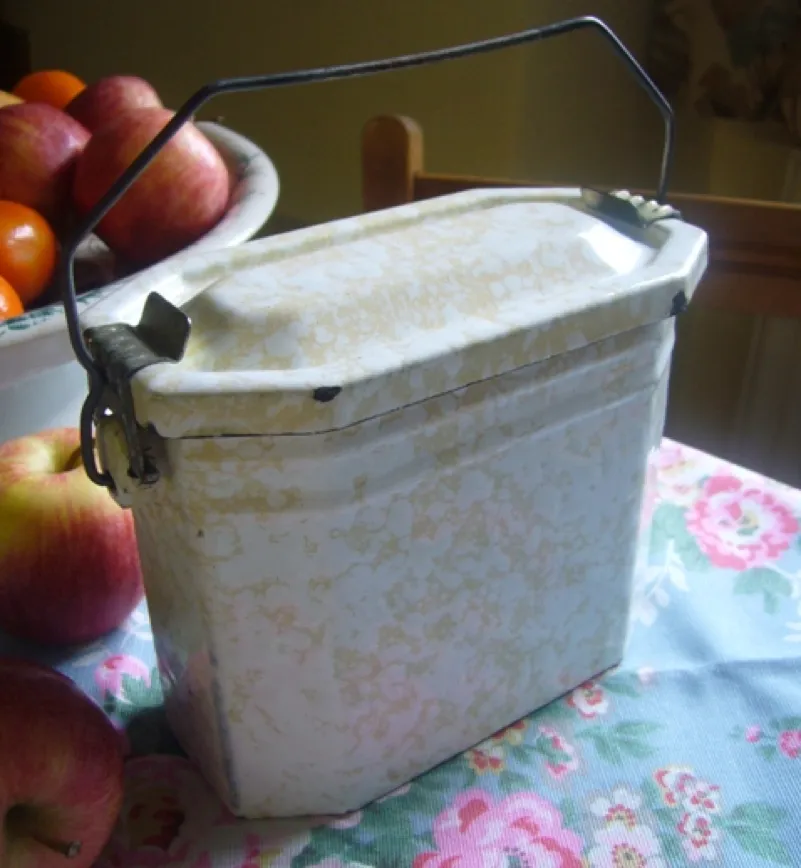Sarah-Jane runs the weekly Twitter vintage networking event #vintagefindhour. In her blog for H&A she’ll be writing about her most recent finds, fair experiences and tales of the interesting folk she meets along the way. This month she shares her love of the humble kitchen staple, enamelware.
Like many vintage fanatics, I caught the collecting bug after discovering a local auction house. Delighted with my bargains and entranced by the buzz of the auction room, I decided to start trading in vintage and antiques in 2006.
Back then, vintage wasn’t the booming business that it has become today - many thought it rather odd when I chose my business name (Vintage Home Shop), vintage mainly being a word reserved for wine and cars.
As time has passed, I have seen vintage fads come and go. One trend that has crept up since 2007 is vintage enamelware.
Enamelware was a household staple from the 19th century until the 1980s and, for some, it remains so today. After its invention in the Victorian era, the practicality and versatility of enamelware took hold and a vast range of products was manufactured worldwide from teapots to door number plaques.
The British brand Falcon (established in 1920) still manufactures classic white and blue enamelware and this year reported a doubling in sales. You can read more about the boom in enamelware in H&A’s July issue.
For me, enamelware conjures up visions of happy campers with mugs hanging from their rucksacks. Though these days it has gone from countryside to high street with brands such as Joules recognising the trend by reproducing coffee pots and mugs adorned with pretty floral designs.
My first few enamelware purchases were a white bread bin, a soap tray and some milk jugs. They sat forlorn and unloved in my shop for quite some time. One elderly gent even recalled his mother owning a similar bread bin but couldn’t understand anyone wanting to part with cash for it (I shudder at the thought of how much enamelware ended up on the scrapheap, particularly the heavier Victorian pots and pans).
Eventually, as I suspected, customers succumbed to enamelware’s rustic charms and made a mini investment without realising.
Nowadays it can be a challenge for a trader to track down these gems in order to turn a profit, though happily for buyers there are many places enamelware can be discovered. A varied selection is readily available via online shops, flea markets and antiques centres, with prices starting from around £10 for plates and pudding bowls. Canisters and storage bins marked with ‘bread’ or ‘flour’ command a higher price, as do complete kitchen storage sets or utensil racks.

If I have a weakness when it comes to enamelware it is for the stuff produced by the French. The pastel palette of lilacs, lemons, dusky pinks, blues and pale greens they used remind me of a plate of delicious macaroons. I once found it extremely hard to part company with a charming French blue circular bread bin with a simple yet stunning art deco design, not to mention a sweet mottled sandwich tin complete with an inner tray and carry handle (like the one pictured, top).
My Twitter #vintagefindhour friend Philippa offers a fine selection of French vintage treasures from her Etsy shop La Vie Nostalgique. Well worth a peek to see what latest finds she has unearthed.
Thanks to my aspirations to farmhouse kitchen wholesomeness, I have hoarded quite a collection to sell myself: saucepans, dishes, bread bins and buckets to name a few. I even have a 1950s kitchen table with a white enamel surface.
There are a few pieces, however, that I could not bear to part with, particularly items with a story attached. One is a little white tea strainer with a small hanging hole to the handle. I’ve yet to see one like it.
It came from a house clearance (quite another story) but as I became familiar with the old farmhouse and the family history that unfolded though its contents, the tea strainer took on a new importance.
Perhaps I am too sentimental but that’s the personality trait that drew me into appreciating the past and preserving little precious pieces of it along the way.
Tweet Sarah-Jane at @vintagehomeshop or join in the #vintagefindhour live chat on Wednesdays at 8pm